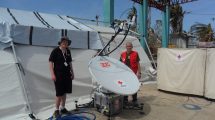 The SPARTACUS project, “Satellite Based Asset Tracking for Supporting Emergency Management in Crisis Operations” was successfully launched three years ago and concludes in October 2016, having achieved the objective of creating an integrated system of spatial and terrestrial technologies to manage emergency and disaster scenarios.
The SPARTACUS project, “Satellite Based Asset Tracking for Supporting Emergency Management in Crisis Operations” was successfully launched three years ago and concludes in October 2016, having achieved the objective of creating an integrated system of spatial and terrestrial technologies to manage emergency and disaster scenarios.
The SPARTACUS project aims to provide accurate tracking and positioning (mapping) of target objects, being principally rail vehicles and wagons, vans and trucks (used by the emergency teams), but also those people (i.e. first responders) helping on the ground during emergency situations. Roberto Carpaneto, Chief Executive Officer at D’Appolonia S.p.A., said, “The key challenge that faced us was integrating the wide variety of tools, standards and protocols used across what, inevitable is an equally wide range of applications. Tracking vehicles was a key consideration. At D’Appolonia we were acutely aware that getting aid and personnel quickly into a disaster location can be the difference between life and death for some victims and that responsibility was foremost in our minds when developing the system”.
The monitoring platform for critical transport (CTAT), managed by D’Appolonia to monitor critical transport assets, together with other Spartacus smart-devices was used successfully as part of a large-scale EU civil protection module exercise, (EU ModEX). The exercise was organized on behalf of the European Commission by a consortium led by Johanniter-Unfall-Hilfe (SPARTACUS partner), comprising: Ministry of the Interior Austria, Crisis Management Centre Finland, Danish Emergency Management Agency and the Italian Civil Protection Department.
A further feasibility test of SPARTACUS solutions took place on September 15 at the Romanian Railway Authority Testing Centre in Faurei (Romania). A specific emergency scenario (i.e. train accident) was designed to demonstrate the SPARTACUS support capabilities during the operational management of a crisis, involving transport assets and first responders.
SPARTACUS has generated a lot of interest at a local, European and international level. Many international aid agencies including the Red Cross are testing, evaluating and validating SPARTACUS. Going forward, D’Appolonia will be at the forefront acting as the application configurator of SPARTACUS system for customers. In that role, D’Appolonia will liaise with those companies providing each of the individual components in order to provide a world-class integrated Emergency asset tracking and communication platform, based on open data and cloud services.










Add Comment